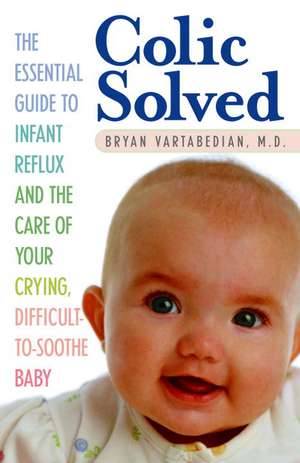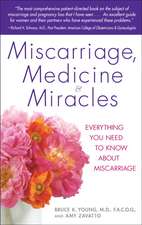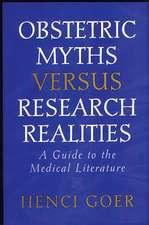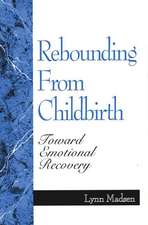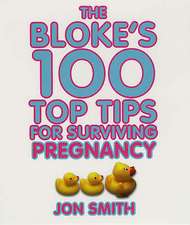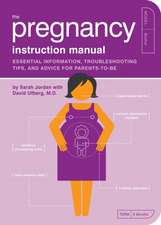Colic Solved: The Essential Guide to Infant Reflux and the Care of Your Crying, Difficult-To- Soothe Baby
Autor Bryan Vartabedianen Limba Engleză Paperback – 31 ian 2007
• Recognize the seven signs of reflux in infancy.
• Discover the role of milk protein allergy–the other colic.
• Learn what, when, and how to feed an irritable baby and the best positions for sleep.
• Recognize the role of formula, breast milk, bottle systems, burping, and pacificers in your baby’s fussiness, and irritability.
• Understand when and why your baby may need testing for reflux.
Weigh the pros and cons of available treatment options.
Identify when a specialist is needed and where to find one.
Complete with inspiring real-life cases of colic solved, plus tips, sidebars, and illustrations, this essential guide provides real answers to a problem that has been upsetting babies–and parents–for years. Help and hope are at hand!
“This is the book for every parent whose young baby is a ‘bundle of misery,’ in pain, and hard to feed, and for that baby’s pediatrician, too.”
–Laura Nathanson, M.D., F.A.A.P., author of The Portable Pediatrician
“Great news for exhausted parents and for suffering babies! Colic Solved gets to the root of what is making many babies cry, and offers powerful, real-world solutions. This is a must-have book for desperate parents everywhere.”
–Alan Greene, MD, FAAP, author of From First Kicks to First Steps and founder of DrGreene.com
Preț: 100.22 lei
Nou
Puncte Express: 150
Preț estimativ în valută:
19.18€ • 19.95$ • 15.83£
19.18€ • 19.95$ • 15.83£
Carte disponibilă
Livrare economică 22 martie-05 aprilie
Preluare comenzi: 021 569.72.76
Specificații
ISBN-13: 9780345490681
ISBN-10: 0345490681
Pagini: 303
Dimensiuni: 134 x 203 x 18 mm
Greutate: 0.22 kg
Editura: BALLANTINE BOOKS
ISBN-10: 0345490681
Pagini: 303
Dimensiuni: 134 x 203 x 18 mm
Greutate: 0.22 kg
Editura: BALLANTINE BOOKS
Extras
1
THE TRUTH ABOUT crying BABIES
If your baby screams, she’s not alone. It’s estimated that about 1 of 5 babies have unexplained irritability. It’s been 50 years since the initial pigeonholing of irritable babies with a condition that we’ve affectionately come to call colic. At the time that colic was first described, doctors had few means of knowing what was going on inside a baby. And in the absence of any better explanation, the idea of a five-letter word to sum it all up was warmly received. And despite what we have come to know, colic as a wastebasket diagnosis remains alive and well, a vestige of history and a comfortable place to put the babies we have such a hard time with. But your baby is screaming for a reason. It’s a cry for help.
THE CASE OF BABY HANNAH
Hannah was 2 months old when she first visited me in my Houston office. Her pediatrician had referred her because he had exhausted all of his resources as a busy primary care pediatrician. Hannah wouldn’t stop crying, and he didn’t know why. The best explanation this seasoned and reputable pediatrician had was that Hannah had colic.
Her problems began at around 2 weeks of age when she began crying after her feeding. Her crying progressed to throughout the day and started to affect her feeding. The pediatrician advised that her mother discontinue breastfeeding her because he feared that breast milk was the problem. Formula feeds began strong, but after a half ounce became difficult, with Hannah arching, pulling from the nipple, and in apparent pain, all while still being hungry and wanting more. The frustration of Hannah’s hour-long feeding episodes were matched only by her sleep, which was regularly interrupted with piercing screams and painful gas.
Her waking hours were marked by nearly constant hiccups and the need to be held and moved. Hannah’s parents were told that she had colic, yet colic medication never seemed to make much of a difference. Formula changes became nearly as frequent as diaper changes, but nothing seemed to make a difference.
The baby’s incessant irritability, impossible feeding, and unpredictable sleeping patterns soon began to take its toll on her parents. When her mother returned to work when Hannah was 3 months old, understanding day care was hard to come by. At the end of their rope with a marriage at its limits, Hannah’s parents came to see me.
WELCOME TO MY WORLD
Whether it’s a pleasure or not, I have the opportunity to work with babies like Hannah every day. Thousands of screaming, miserable, sleepless, and impossible-to-feed babies have found their way to my office over the past several years, some sicker than others, but all delivered by desperate parents looking for answers and looking for help. This book is about what I’ve learned and what I know.
I’ve always said that it was far easier being a pediatrician before I ever had children of my own. Calls in the middle of the night from the sleepless parents of screaming babies were handled as a matter of course early on in my career. But despite my comforting words, my attitude beneath was “Deal with it.” I had bought into the idea that all babies scream and that some babies scream because of the stress and pressure that young parents convey to their babies. While I have always done my best to evaluate and treat every baby thoroughly, I was very much inside the system at first . . . a paternalistic, board- certified know-it-all with 6 years of residency and fellowship training at America’s largest children’s hospital. But I had never lived with a baby. More important, I had never lived with a baby with reflux.
The birth of my daughter, Laura, represented a turning point for me as a pediatrician. Laura was a lot like Hannah, with the exception that her father was a pediatric gastroenterologist. And with that came expectations from my wife to make things better. Laura was treated for acid reflux and morphed from a bundle of misery to something far more tolerable. I was vindicated as both a father and a physician, and my view of the screaming baby has never been the same.
I should note that my son, Nicholas, happily spit everywhere and all the time until nearly a year of age. But for us this was nothing more than an inconvenience. In nearly all of his baby pictures, he is wearing a crusty burp bib intended to protect the expensive outfits we bought him as the firstborn. So you could say that I’ve had it both ways: a bundle of misery and a happy spitter, two patterns that you’ll read about in Chapter 3, “Seven Signs of Reflux in Your Baby.”
For better or worse, I can now empathize with the families I see—for better because I can understand their situation and react to it more sensitively; for worse because I can understand their situation and relive the misery that they feel whenever I’m called to evaluate a screamer.
COLIC—THE DIAGNOSIS FOR ALL OCCASIONS
Unfortunately, not everyone has a pediatric gastroenterologist as a father. In many cases, babies are left alone to cry, either by parents who don’t know how to advocate for them or by doctors who don’t know where to turn. In fact, in Hannah’s case the diagnosis was colic because there was nothing else to explain her problem and the symptoms loosely fit with something that her pediatrician had been taught many years ago.
So What Is Colic?
The quest for the cause of colic or even an agreed-on definition of it over the last half century has amounted to something of an optical illusion. Like one of those abstract images that you must stare at for minutes on end before actually identifying the picture, colic has been something of an elusive diagnosis among pediatricians. And the many who never quite see it ultimately agree that they see it just so they won’t have to continue squinting.
I’ll have to admit that from early on in my career I was never able to see the pretty picture when it came to the illusion of colic. While I’ve evaluated and treated thousands of irritable babies, the problem is that I’ve never seen colic and can’t get straight answers about what it is or what it looks like from those who claim to have seen it. Like the UFOs that seem to land everywhere but at Harvard and MIT, colic has evolved into one of our culture’s greatest urban legends—a mythical explanation meant to explain the seemingly unexplainable.
A Baby Cannot “Have” Colic
The problem comes with the fact that colic is a description and not a disease. This descriptive term has, in turn, been morphed into a real and recognizable condition that served an important role for parents and pediatricians in our not-so-distant past. Much as fables and myths help provide order and explanation for different cultures, colic was once a comfortable resting place for weary pediatricians dealing with weary parents. And when medical science failed to offer any better explanation, it served to conveniently absolve the pediatrician from any further responsibility to parent or child.
Because colic represents a pattern of behavior and not a disease, a baby cannot “have” colic or have it “diagnosed.” Much like fever or weight loss that typically represent signs of some other problem in a child, colic doesn’t stand on its own as a diagnosis. To use the words diagnosis and colic together suggests that intelligent, established criteria, backed up by clinical research, were used to come to that conclusion. But unfortunately, such criteria or compelling clinical studies don’t exist. In the words of a distinguished researcher on the topic of infant irritability recently quoted in the Journal of Pediatric Gastroenterology and Nutrition, “The term colic implies a mechanism responsible for the distress displayed by these infants. Such a mechanism has never been demonstrated.”
Colic—Whatever You Want It to Be
But colic advocates and researchers who have built their careers on the urban legend that is colic will beg to differ. The criterion they use, as determined in 1954, suggests that the diagnosis should be considered in babies who experience inconsolable screaming for 3 days a week, for 3 hours a day, for at least 3 weeks a month. Unfortunately, if your baby screams for only 2 hours and 45 minutes for only 20 days straight, you’re a day early and a dollar short. Had I created criteria for colic, I would have suggested adding the fact that you haven’t had sex with your spouse in 3 months, you’re up 3 hours each night, and you’re 3 weeks away from losing your job unless you get some sleep. But I wasn’t practicing in the 1950s, and things were different then.
If we give our 1950s’ researchers the benefit of the doubt and accept the out-of-thin-air rule of threes, as it is called, not everyone sticks to it. In fact, when it comes to the diagnosis of colic, everyone seems to have his or her own rules. A colleague whom I work closely with will diagnose colic only if the baby cannot be put down. Another employs a white-noise rule—the diagnosis is confirmed if the baby settles with the sound of a vacuum cleaner, hair dryer, or other loud neutralizing sound. It seems that the number of random, self- imposed criteria for diagnosis are limited only by the imagination.
So despite the complete absence of a consensus of what constitutes colic, it remains nonetheless a convenient wastebasket diagnosis that can be retrofitted to suit the need of the individual making the diagnosis. If you haven’t caught on, colic would appear to be a well- orchestrated five-letter defense mechanism for doctors who are either outdated, outwitted, or just plain out of ideas.
THE COLIC REVOLUTION—SCREAMING INTO
THE TWENTY-FIRST CENTURY
Our experience and medical research tell us that babies scream for a reason. While Colic Solved doesn’t intend to suggest that there aren’t high-need babies or those with sensitive developing nervous systems, it is here to introduce the idea that something physical may in fact be wrong.
In a sense, this book is the result of a revolution in pediatric medicine—a culmination of technology and insight. Advances in endoscopy (viewing the inside of body organs or cavities with a device that uses flexible fiber optics), pharmacology, and nutrition have allowed us to rethink why babies cry. In the twentieth century, we called it colic only because no one knew any better. And while developments in conquering diseases such as polio and smallpox obviously take center stage, other seemingly less impressive advances are important minor characters. Our understanding of the irritable baby is one of them.
Technology Has Changed Our Babies for the Better
So what are the changes in pediatric health care that have created a better understanding of why babies do what they do?
•The creation of pediatric gastroenterology as a specialty. While there have been pediatricians dedicated to the understanding of pediatric digestive health since the early 1900s, it was the formal organization of the field of pediatric gastroenterology that has created an atmosphere of
organized discussion and research. The subspecialty of pediatric gastroenterology was recognized by the American Board of Medical Specialties in 1988, and since then the number of trained gastrointestinal (GI) specialists conducting research and setting the standards of care has continued to grow. Alongside the expansion of gastroenterology as a pediatric subspecialty has been the development of smaller endoscopes (flexible-tube optical instruments that use fiber optics to illuminate the inside of the intestinal tract) for understanding what happens in a baby’s digestive system. pH probes came into popular use by pediatric gastroenterologists in the 1980s, allowing doctors to begin to associate patterns of reflux with patterns of irritability. (pH is a measure of acidity or alkalinity of a substance.)
•Identification of reflux as a key contributor to a number of common conditions. Beyond simply understanding acid reflux (the backflow of stomach acid into the esophagus, the muscular tube that carries food and drink to the stomach) in babies, this evolution of technology involving fiber-optic endoscopes and pH probes has allowed the correlation of reflux with other problems such as asthma, sinus conditions, and feeding disorders.
•The advancement of infant nutrition. Understanding of the growing immune system has led to the development of hypoallergenic formulas, specifically superhypoallergenic formula, which became available for common use in the early 1990s. This has revolutionized the care and feeding of the infant with severe allergic disease. Our ability to understand the reactions of the intestinal immune system has been furthered by our ability to “see” intestinal allergy with endoscopic technology. And while we continue to learn more and more about the incredible benefits of breastfeeding, formula manufacturers are learning from it to benefit babies who can’t breastfeed. Formulas, which were once nothing more than a vehicle for protein, fat, and carbohydrate, now sometimes contain long-chain fatty acids that have been shown to improve visual and cognitive function in infancy and beyond.
•The evolution of pediatric drug development. The development and improvement of safe, effective antacids for use in children have revolutionized the way we see and care for the screaming baby. The technology of drug delivery has provided pediatricians with more options for facing the challenge of administering medicine to infants and children. And recent changes in federal law now mandate clinical trials (research studies) in children for many of the new drugs being released for adults.
•The popularization of the Internet. While many doctors consider it a curse, the Internet has empowered parents to network and ask questions about their baby’s misery. Parents whose babies have been dealt the once dead-end diagnosis of colic now are learning in chat rooms and on Web sites that there may be identifiable and treatable problems at work. While the Web has the downside of sometimes offering too much information, its ability to raise questions is unparalleled.
So as we enter the twenty-first century, it sure seems like a great time to be a baby, particularly one who screams. All of these developments have made it easier to help the fussy baby.
Why Hannah Is Screaming
We now know that children with the type of irritability described as colic often suffer with either reflux or milk protein allergy.
A major study reported in 2004 by one of the world’s most respected reflux researchers created quite a stir in the medical community. Clinical researchers treated a group of irritable babies with hypoallergenic formula. The babies whose symptoms didn’t lessen when they were given hypoallergenic formula were then evaluated for the presence of gastroesophageal reflux using endoscopy and a pH probe (you’ll learn more about these in Chapter 8, “A Parent’s Guide to Tests and Studies,” but for now understand that this is how reflux is formally assessed). Of 60 markedly irritable infants between the ages of 1 and 6 months, 66% had pH probe results consistent with abnormal reflux and 43% had evidence of acid reflux injury shown by biopsy of the esophagus. While the report’s authors make it clear that proving an absolute cause-and-effect relationship between crying and obvious reflux can be difficult, the results are thought-provoking.
THE TRUTH ABOUT crying BABIES
If your baby screams, she’s not alone. It’s estimated that about 1 of 5 babies have unexplained irritability. It’s been 50 years since the initial pigeonholing of irritable babies with a condition that we’ve affectionately come to call colic. At the time that colic was first described, doctors had few means of knowing what was going on inside a baby. And in the absence of any better explanation, the idea of a five-letter word to sum it all up was warmly received. And despite what we have come to know, colic as a wastebasket diagnosis remains alive and well, a vestige of history and a comfortable place to put the babies we have such a hard time with. But your baby is screaming for a reason. It’s a cry for help.
THE CASE OF BABY HANNAH
Hannah was 2 months old when she first visited me in my Houston office. Her pediatrician had referred her because he had exhausted all of his resources as a busy primary care pediatrician. Hannah wouldn’t stop crying, and he didn’t know why. The best explanation this seasoned and reputable pediatrician had was that Hannah had colic.
Her problems began at around 2 weeks of age when she began crying after her feeding. Her crying progressed to throughout the day and started to affect her feeding. The pediatrician advised that her mother discontinue breastfeeding her because he feared that breast milk was the problem. Formula feeds began strong, but after a half ounce became difficult, with Hannah arching, pulling from the nipple, and in apparent pain, all while still being hungry and wanting more. The frustration of Hannah’s hour-long feeding episodes were matched only by her sleep, which was regularly interrupted with piercing screams and painful gas.
Her waking hours were marked by nearly constant hiccups and the need to be held and moved. Hannah’s parents were told that she had colic, yet colic medication never seemed to make much of a difference. Formula changes became nearly as frequent as diaper changes, but nothing seemed to make a difference.
The baby’s incessant irritability, impossible feeding, and unpredictable sleeping patterns soon began to take its toll on her parents. When her mother returned to work when Hannah was 3 months old, understanding day care was hard to come by. At the end of their rope with a marriage at its limits, Hannah’s parents came to see me.
WELCOME TO MY WORLD
Whether it’s a pleasure or not, I have the opportunity to work with babies like Hannah every day. Thousands of screaming, miserable, sleepless, and impossible-to-feed babies have found their way to my office over the past several years, some sicker than others, but all delivered by desperate parents looking for answers and looking for help. This book is about what I’ve learned and what I know.
I’ve always said that it was far easier being a pediatrician before I ever had children of my own. Calls in the middle of the night from the sleepless parents of screaming babies were handled as a matter of course early on in my career. But despite my comforting words, my attitude beneath was “Deal with it.” I had bought into the idea that all babies scream and that some babies scream because of the stress and pressure that young parents convey to their babies. While I have always done my best to evaluate and treat every baby thoroughly, I was very much inside the system at first . . . a paternalistic, board- certified know-it-all with 6 years of residency and fellowship training at America’s largest children’s hospital. But I had never lived with a baby. More important, I had never lived with a baby with reflux.
The birth of my daughter, Laura, represented a turning point for me as a pediatrician. Laura was a lot like Hannah, with the exception that her father was a pediatric gastroenterologist. And with that came expectations from my wife to make things better. Laura was treated for acid reflux and morphed from a bundle of misery to something far more tolerable. I was vindicated as both a father and a physician, and my view of the screaming baby has never been the same.
I should note that my son, Nicholas, happily spit everywhere and all the time until nearly a year of age. But for us this was nothing more than an inconvenience. In nearly all of his baby pictures, he is wearing a crusty burp bib intended to protect the expensive outfits we bought him as the firstborn. So you could say that I’ve had it both ways: a bundle of misery and a happy spitter, two patterns that you’ll read about in Chapter 3, “Seven Signs of Reflux in Your Baby.”
For better or worse, I can now empathize with the families I see—for better because I can understand their situation and react to it more sensitively; for worse because I can understand their situation and relive the misery that they feel whenever I’m called to evaluate a screamer.
COLIC—THE DIAGNOSIS FOR ALL OCCASIONS
Unfortunately, not everyone has a pediatric gastroenterologist as a father. In many cases, babies are left alone to cry, either by parents who don’t know how to advocate for them or by doctors who don’t know where to turn. In fact, in Hannah’s case the diagnosis was colic because there was nothing else to explain her problem and the symptoms loosely fit with something that her pediatrician had been taught many years ago.
So What Is Colic?
The quest for the cause of colic or even an agreed-on definition of it over the last half century has amounted to something of an optical illusion. Like one of those abstract images that you must stare at for minutes on end before actually identifying the picture, colic has been something of an elusive diagnosis among pediatricians. And the many who never quite see it ultimately agree that they see it just so they won’t have to continue squinting.
I’ll have to admit that from early on in my career I was never able to see the pretty picture when it came to the illusion of colic. While I’ve evaluated and treated thousands of irritable babies, the problem is that I’ve never seen colic and can’t get straight answers about what it is or what it looks like from those who claim to have seen it. Like the UFOs that seem to land everywhere but at Harvard and MIT, colic has evolved into one of our culture’s greatest urban legends—a mythical explanation meant to explain the seemingly unexplainable.
A Baby Cannot “Have” Colic
The problem comes with the fact that colic is a description and not a disease. This descriptive term has, in turn, been morphed into a real and recognizable condition that served an important role for parents and pediatricians in our not-so-distant past. Much as fables and myths help provide order and explanation for different cultures, colic was once a comfortable resting place for weary pediatricians dealing with weary parents. And when medical science failed to offer any better explanation, it served to conveniently absolve the pediatrician from any further responsibility to parent or child.
Because colic represents a pattern of behavior and not a disease, a baby cannot “have” colic or have it “diagnosed.” Much like fever or weight loss that typically represent signs of some other problem in a child, colic doesn’t stand on its own as a diagnosis. To use the words diagnosis and colic together suggests that intelligent, established criteria, backed up by clinical research, were used to come to that conclusion. But unfortunately, such criteria or compelling clinical studies don’t exist. In the words of a distinguished researcher on the topic of infant irritability recently quoted in the Journal of Pediatric Gastroenterology and Nutrition, “The term colic implies a mechanism responsible for the distress displayed by these infants. Such a mechanism has never been demonstrated.”
Colic—Whatever You Want It to Be
But colic advocates and researchers who have built their careers on the urban legend that is colic will beg to differ. The criterion they use, as determined in 1954, suggests that the diagnosis should be considered in babies who experience inconsolable screaming for 3 days a week, for 3 hours a day, for at least 3 weeks a month. Unfortunately, if your baby screams for only 2 hours and 45 minutes for only 20 days straight, you’re a day early and a dollar short. Had I created criteria for colic, I would have suggested adding the fact that you haven’t had sex with your spouse in 3 months, you’re up 3 hours each night, and you’re 3 weeks away from losing your job unless you get some sleep. But I wasn’t practicing in the 1950s, and things were different then.
If we give our 1950s’ researchers the benefit of the doubt and accept the out-of-thin-air rule of threes, as it is called, not everyone sticks to it. In fact, when it comes to the diagnosis of colic, everyone seems to have his or her own rules. A colleague whom I work closely with will diagnose colic only if the baby cannot be put down. Another employs a white-noise rule—the diagnosis is confirmed if the baby settles with the sound of a vacuum cleaner, hair dryer, or other loud neutralizing sound. It seems that the number of random, self- imposed criteria for diagnosis are limited only by the imagination.
So despite the complete absence of a consensus of what constitutes colic, it remains nonetheless a convenient wastebasket diagnosis that can be retrofitted to suit the need of the individual making the diagnosis. If you haven’t caught on, colic would appear to be a well- orchestrated five-letter defense mechanism for doctors who are either outdated, outwitted, or just plain out of ideas.
THE COLIC REVOLUTION—SCREAMING INTO
THE TWENTY-FIRST CENTURY
Our experience and medical research tell us that babies scream for a reason. While Colic Solved doesn’t intend to suggest that there aren’t high-need babies or those with sensitive developing nervous systems, it is here to introduce the idea that something physical may in fact be wrong.
In a sense, this book is the result of a revolution in pediatric medicine—a culmination of technology and insight. Advances in endoscopy (viewing the inside of body organs or cavities with a device that uses flexible fiber optics), pharmacology, and nutrition have allowed us to rethink why babies cry. In the twentieth century, we called it colic only because no one knew any better. And while developments in conquering diseases such as polio and smallpox obviously take center stage, other seemingly less impressive advances are important minor characters. Our understanding of the irritable baby is one of them.
Technology Has Changed Our Babies for the Better
So what are the changes in pediatric health care that have created a better understanding of why babies do what they do?
•The creation of pediatric gastroenterology as a specialty. While there have been pediatricians dedicated to the understanding of pediatric digestive health since the early 1900s, it was the formal organization of the field of pediatric gastroenterology that has created an atmosphere of
organized discussion and research. The subspecialty of pediatric gastroenterology was recognized by the American Board of Medical Specialties in 1988, and since then the number of trained gastrointestinal (GI) specialists conducting research and setting the standards of care has continued to grow. Alongside the expansion of gastroenterology as a pediatric subspecialty has been the development of smaller endoscopes (flexible-tube optical instruments that use fiber optics to illuminate the inside of the intestinal tract) for understanding what happens in a baby’s digestive system. pH probes came into popular use by pediatric gastroenterologists in the 1980s, allowing doctors to begin to associate patterns of reflux with patterns of irritability. (pH is a measure of acidity or alkalinity of a substance.)
•Identification of reflux as a key contributor to a number of common conditions. Beyond simply understanding acid reflux (the backflow of stomach acid into the esophagus, the muscular tube that carries food and drink to the stomach) in babies, this evolution of technology involving fiber-optic endoscopes and pH probes has allowed the correlation of reflux with other problems such as asthma, sinus conditions, and feeding disorders.
•The advancement of infant nutrition. Understanding of the growing immune system has led to the development of hypoallergenic formulas, specifically superhypoallergenic formula, which became available for common use in the early 1990s. This has revolutionized the care and feeding of the infant with severe allergic disease. Our ability to understand the reactions of the intestinal immune system has been furthered by our ability to “see” intestinal allergy with endoscopic technology. And while we continue to learn more and more about the incredible benefits of breastfeeding, formula manufacturers are learning from it to benefit babies who can’t breastfeed. Formulas, which were once nothing more than a vehicle for protein, fat, and carbohydrate, now sometimes contain long-chain fatty acids that have been shown to improve visual and cognitive function in infancy and beyond.
•The evolution of pediatric drug development. The development and improvement of safe, effective antacids for use in children have revolutionized the way we see and care for the screaming baby. The technology of drug delivery has provided pediatricians with more options for facing the challenge of administering medicine to infants and children. And recent changes in federal law now mandate clinical trials (research studies) in children for many of the new drugs being released for adults.
•The popularization of the Internet. While many doctors consider it a curse, the Internet has empowered parents to network and ask questions about their baby’s misery. Parents whose babies have been dealt the once dead-end diagnosis of colic now are learning in chat rooms and on Web sites that there may be identifiable and treatable problems at work. While the Web has the downside of sometimes offering too much information, its ability to raise questions is unparalleled.
So as we enter the twenty-first century, it sure seems like a great time to be a baby, particularly one who screams. All of these developments have made it easier to help the fussy baby.
Why Hannah Is Screaming
We now know that children with the type of irritability described as colic often suffer with either reflux or milk protein allergy.
A major study reported in 2004 by one of the world’s most respected reflux researchers created quite a stir in the medical community. Clinical researchers treated a group of irritable babies with hypoallergenic formula. The babies whose symptoms didn’t lessen when they were given hypoallergenic formula were then evaluated for the presence of gastroesophageal reflux using endoscopy and a pH probe (you’ll learn more about these in Chapter 8, “A Parent’s Guide to Tests and Studies,” but for now understand that this is how reflux is formally assessed). Of 60 markedly irritable infants between the ages of 1 and 6 months, 66% had pH probe results consistent with abnormal reflux and 43% had evidence of acid reflux injury shown by biopsy of the esophagus. While the report’s authors make it clear that proving an absolute cause-and-effect relationship between crying and obvious reflux can be difficult, the results are thought-provoking.
Descriere
The first book to offer practical solutions to the previously unsolvable nightmare of colic, noted pediatric gastroenterologist Vartabedian suggests that irritable, screaming babies may suffer from a treatable condition called infant reflux and offers parents advice on treating this common problem.
Notă biografică
Bryan Vartabedian, M.D.
